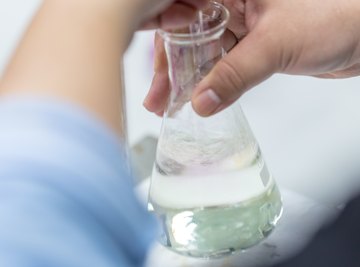
If you monitor the pH throughout a titration, you can plot your data afterward to make a graph called a titration curve. Use this curve to figure out the concentration of the chemical in the solution for analysis, also called the analyte. The point on the titration curve at which all of the analyte has been neutralized is called the equivalence point, and on the graph it appears as an inflection point — the steepest part of the entire curve, which is usually s-shaped. Once you find the equivalence point on your curve, you are ready to calculate.
- Pencil
- Paper
- Calculator
- Titration curve
A polyprotic acid or base in the analyte yields a titration curve with multiple equivalence points. Use any one of the equivalence points in your calculation, however it is generally easiest to use the first point.
Determine how much titrant (the chemical you added to the analyte during the titration) you used to reach the equivalence point. If there are multiple equivalence points on the graph, choose the first one, i.e., the one closest to the left of the graph. If a homework problem gives you a titration curve for an experiment you did not perform, the volume of titrant added is on the x-axis. Find the value of x at the equivalence point to find the volume of titrant used to get there.
Multiply the volume of titrant used by its concentration. If you performed an experiment in the lab, you figured out the concentration of your titrant before doing the titration. Alternatively, a homework problem should give you the concentration of the titrant to use in your calculations. Remember to change volume from milliliters to liters. For example, if the volume of titrant added was 200 mL and its concentration was 0.1 molar, you would change from milliliters to liters by dividing by 1000. Therefore, 100 mL ÷ 1000 mL/L = 0.1 L. Next, multiply the molarity by the volume, as follows: (0.1 L) x (0.1 M) = 0.01 moles. This provides the amount of titrant chemical added to reach the first equivalence point.
Determine the number of moles of analyte originally present. This is equal to the number of moles of titrant needed to reach the first equivalence point — the same number you just calculated in Step 2. For example, if you added 0.01 moles of titrant to reach the first equivalence point, you know there were 0.01 moles of analyte present.
Divide the number of moles of analyte present by the original volume of the analyte. For example, if the original volume of the analyte was 500 mL, divide by 1000 mL per L to obtain 0.5 L. Divide 0.01 moles of analyte by 0.5 L to obtain 0.02 moles per liter. This is the concentration or molarity.
Things You'll Need
Tips
References
Tips
- A polyprotic acid or base in the analyte yields a titration curve that has multiple equivalence points. You could use any one of the equivalence points in your calculation, but it's easiest to use the first as a general rule.
About the Author
Based in San Diego, John Brennan has been writing about science and the environment since 2006. His articles have appeared in "Plenty," "San Diego Reader," "Santa Barbara Independent" and "East Bay Monthly." Brennan holds a Bachelor of Science in biology from the University of California, San Diego.
